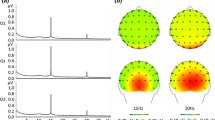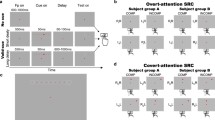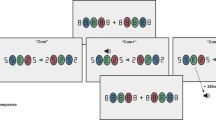Abstract
In daily life, selecting an object visually is closely intertwined with processing that object as a potential goal for action. Since visual and motor goals are typically identical, it remains unknown whether attention is primarily allocated to a visual target, a motor goal, or both. Here, we dissociated visual and motor goals using a visuomotor adaptation paradigm, in which participants reached toward a visual target using a computer mouse or a stylus pen, while the direction of the cursor was rotated 45° counter-clockwise from the direction of the hand movement. Thus, as visuomotor adaptation was accomplished, the visual target was dissociated from the movement goal. Then, we measured the locus of attention using an attention-demanding rapid serial visual presentation (RSVP) task, in which participants detected a pre-defined visual stimulus among the successive visual stimuli presented on either the visual target, the motor goal, or a neutral control location. We demonstrated that before visuomotor adaptation, participants performed better when the RSVP stream was presented at the visual target than at other locations. However, once visual and motor goals were dissociated following visuomotor adaptation, performance at the visual and motor goals was equated and better than performance at the control location. Therefore, we concluded that attentional resources are allocated both to visual target and motor goals during goal-directed reaching movements.



Similar content being viewed by others
References
Baldauf D, Deubel H (2008a) Properties of attentional selection during the preparation of sequential saccades. Exp Brain Res 184:411–425
Baldauf D, Deubel H (2008b) Visual attention during the preparation of bimanual movements. Vision Res 48:549–563
Baldauf D, Deubel H (2009) Attentional selection of multiple goal positions before rapid hand movement sequences: an event-related potential study. J Cogn Neurosci 21:18–29
Baldauf D, Wolf M, Deubel H (2006) Deployment of visual attention before sequences of goal-directed hand movements. Vision Res 46:4355–4374
Basso MA, Wurtz RH (1998) Modulation of neuronal activity in superior colliculus by changes in target probability. J Neurosci 18:7519–7534
Beauchamp MS, Petit L, Ellmore TM, Ingeholm J, Haxby JV (2001) A parametric fMRI study of overt and covert shifts of visuospatial attention. Neuroimage 14:310–321
Bedard P, Sanes JN (2011) Basal ganglia-dependent processes in recalling learned visual-motor adaptations. Exp Brain Res 209:385–393
Bichot NP, Schall JD (1999) Saccade target selection in macaque during feature and conjunction visual search. Vis Neurosci 16:81–89
Boussaoud D (2001) Attention versus intention in the primate premotor cortex. Neuroimage 14:S40–S45
Boussaoud D, Wise SP (1993) Primate frontal cortex: neuronal activity following attentional versus intentional cues. Exp Brain Res 95:15–27
Brainard DH (1997) The Psychophysics Toolbox. Spat Vis 10:433–436
Bravo MJ, Nakayama K (1992) The role of attention in different visual-search tasks. Percept Psychophys 51:465–472
Carello CD, Krauzlis RJ (2004) Manipulating intent: evidence for a causal role of the superior colliculus in target selection. Neuron 43:575–583
Cavanaugh J, Wurtz RH (2004) Subcortical modulation of attention counters change blindness. J Neurosci 24:11236–11243
Cisek P, Kalaska JF (2005) Neural correlates of reaching decisions in dorsal premotor cortex: specification of multiple direction choices and final selection of action. Neuron 45:801–814
Cisek P, Kalaska JF (2010) Neural mechanisms for interacting with a world full of action choices. Annu Rev Neurosci 33:269–298
Collins T, Schicke T, Roder B (2008) Action goal selection and motor planning can be dissociated by tool use. Cognition 109:363–371
Collins T, Heed T, Roder B (2010) Visual target selection and motor planning define attentional enhancement at perceptual processing stages. Front Hum Neurosci 4:14
Corbetta M, Akbudak E, Conturo TE, Snyder AZ, Ollinger JM, Drury HA, Linenweber MR, Petersen SE, Raichle ME, Van Essen DC, Shulman GL (1998) A common network of functional areas for attention and eye movements. Neuron 21:761–773
Cutrell EB, Marrocco RT (2002) Electrical microstimulation of primate posterior parietal cortex initiates orienting and alerting components of covert attention. Exp Brain Res 144:103–113
Deubel H, Schneider WX (1996) Saccade target selection and object recognition: evidence for a common attentional mechanism. Vision Res 36:1827–1837
Deubel H, Schneider WX (2003) Delayed saccades, but not delayed manual aiming movements, require visual attention shifts. Ann N Y Acad Sci 1004:289–296
Gabrieli JD, Corkin S, Mickel SF, Growdon JH (1993) Intact acquisition and long-term retention of mirror-tracing skill in Alzheimer’s disease and in global amnesia. Behav Neurosci 107:899–910
Gersch TM, Kowler E, Dosher B (2004) Dynamic allocation of visual attention during the execution of sequences of saccades. Vision Res 44:1469–1483
Hegele M, Heuer H (2010) Implicit and explicit components of dual adaptation to visuomotor rotations. Conscious Cogn 19:906–917
Heinze HJ, Mangun GR, Burchert W, Hinrichs H, Scholz M, Munte TF, Gos A, Scherg M, Johannes S, Hundeshagen H et al (1994) Combined spatial and temporal imaging of brain activity during visual selective attention in humans. Nature 372:543–546
Hoffman JE, Subramaniam B (1995) The role of visual attention in saccadic eye movements. Percept Psychophys 57:787–795
Hopp JJ, Fuchs AF (2004) The characteristics and neuronal substrate of saccadic eye movement plasticity. Prog Neurobiol 72:27–53
Horwitz GD, Newsome WT (1999) Separate signals for target selection and movement specification in the superior colliculus. Science 284:1158–1161
Huang L, Dobkins KR (2005) Attentional effects on contrast discrimination in humans: evidence for both contrast gain and response gain. Vision Res 45:1201–1212
Indovina I, Sanes JN (2001) Combined visual attention and finger movement effects on human brain representations. Exp Brain Res 140:265–279
Ingram HA, van Donkelaar P, Cole J, Vercher JL, Gauthier GM, Miall RC (2000) The role of proprioception and attention in a visuomotor adaptation task. Exp Brain Res 132:114–126
Joseph JS, Chun MM, Nakayama K (1997) Attentional requirements in a ‘preattentive’ feature search task. Nature 387:805–807
Kagerer FA, Contreras-Vidal JL, Stelmach GE (1997) Adaptation to gradual as compared with sudden visuo-motor distortions. Exp Brain Res 115:557–561
Khan AZ, Heinen SJ, McPeek RM (2010) Attentional cueing at the saccade goal, not at the target location, facilitates saccades. J Neurosci 30:5481–5488
Khan AZ, Song JH, McPeek RM (2011) The eye dominates in guiding attention during simultaneous eye and hand movements. J Vis 11:1–14
Kim B, Basso MA (2008) Saccade target selection in the superior colliculus: a signal detection theory approach. J Neurosci 28:2991–3007
Klassen J, Tong C, Flanagan JR (2005) Learning and recall of incremental kinematic and dynamic sensorimotor transformations. Exp Brain Res 164:250–259
Kowler E, Anderson E, Dosher B, Blaser E (1995) The role of attention in the programming of saccades. Vision Res 35:1897–1916
Krakauer JW (2009) Motor learning and consolidation: the case of visuomotor rotation. Adv Exp Med Biol 629:405–421
Krakauer JW, Ghez C, Ghilardi MF (2005) Adaptation to visuomotor transformations: consolidation, interference, and forgetting. J Neurosci 25:473–478
Krauzlis R, Dill N (2002) Neural correlates of target choice for pursuit and saccades in the primate superior colliculus. Neuron 35:355–363
Lebedev MA, Wise SP (2001) Tuning for the orientation of spatial attention in dorsal premotor cortex. Eur J Neurosci 13:1002–1008
Lovejoy LP, Krauzlis RJ (2010) Inactivation of primate superior colliculus impairs covert selection of signals for perceptual judgments. Nat Neurosci 13:261–266
Luck SJ, Hillyard SA (1995) The role of attention in feature detection and conjunction discrimination: an electrophysiological analysis. Int J Neurosci 80:281–297
Malfait N, Ostry DJ (2004) Is interlimb transfer of force-field adaptation a cognitive response to the sudden introduction of load? J Neurosci 24:8084–8089
Maljkovic V, Nakayama K (1994) Priming of pop-out: I. Role of features. Mem Cognit 22:657–672
Mangun GR, Hillyard SA (1988) Spatial gradients of visual attention: behavioral and electrophysiological evidence. Electroencephalogr Clin Neurophysiol 70:417–428
Mangun GR, Hillyard SA (1990) Allocation of visual attention to spatial locations: tradeoff functions for event-related brain potentials and detection performance. Percept Psychophys 47:532–550
Mazzoni P, Krakauer JW (2006) An implicit plan overrides an explicit strategy during visuomotor adaptation. J Neurosci 26:3642–3645
McAdams CJ, Maunsell JH (1999) Effects of attention on the reliability of individual neurons in monkey visual cortex. Neuron 23:765–773
McLaughlin SC, Webster RG (1967) Changes in straight-ahead eye position during adaptation to wedge prisms. Percept Psychophys 2:37–44
McPeek RM, Keller EL (2004) Deficits in saccade target selection after inactivation of superior colliculus. Nat Neurosci 7:757–763
McSorley E, Findlay JM (2003) Saccade target selection in visual search: accuracy improves when more distractors are present. J Vis 3:877–892
Moore T, Fallah M (2001) Control of eye movements and spatial attention. Proc Natl Acad Sci USA 98:1273–1276
Muller JR, Philiastides MG, Newsome WT (2005) Microstimulation of the superior colliculus focuses attention without moving the eyes. Proc Natl Acad Sci USA 102:524–529
Neggers SF, Bekkering H (2000) Ocular gaze is anchored to the target of an ongoing pointing movement. J Neurophysiol 83:639–651
Nobre AC, Gitelman DR, Dias EC, Mesulam MM (2000) Covert visual spatial orienting and saccades: overlapping neural systems. Neuroimage 11:210–216
Nummela SU, Krauzlis RJ (2010) Inactivation of primate superior colliculus biases target choice for smooth pursuit, saccades, and button press responses. J Neurophysiol 104:1538–1548
Palmer J, Verghese P, Pavel M (2000) The psychophysics of visual search. Vision Res 40:1227–1268
Pelli DG (1997) The VideoToolbox software for visual psychophysics: transforming numbers into movies. Spat Vis 10:437–442
Pesaran B, Nelson MJ, Andersen RA (2008) Free choice activates a decision circuit between frontal and parietal cortex. Nature 453:406–409
Raymond JE, Shapiro KL, Arnell KM (1992) Temporary suppression of visual processing in an RSVP task: an attentional blink? J Exp Psychol Hum Percept Perform 18:849–860
Reynolds JH, Heeger DJ (2009) The normalization model of attention. Neuron 61:168–185
Rizzolatti G, Riggio L, Sheliga BM (1994) Attention and performance XV: conscious and nonconscious information processing—Umilta, C, Moscovitch, M. J Psychophysiol 11:232–265
Shadmehr R, Wise SP (2005) The computational neurobiology of reaching and pointing: a foundation for motor learning. MIT Press, Cambridge, MA
Shadmehr R, Brandt J, Corkin S (1998) Time-dependent motor memory processes in amnesic subjects. J Neurophysiol 80:1590–1597
Sheliga BM, Riggio L, Rizzolatti G (1995) Spatial attention and eye movements. Exp Brain Res 105:261–275
Snyder LH, Batista AP, Andersen RA (2000) Intention-related activity in the posterior parietal cortex: a review. Vision Res 40:1433–1441
Somers DC, Dale AM, Seiffert AE, Tootell RBH (1999) Functional MRI reveals spatially specific attentional modulation in human primary visual cortex. Proc Natl Acad Sci USA 96:1663–1668
Song J-H, McPeek RM (2009) Eye-hand coordination during target selection in a pop-out visual search. J Neurophysiol 102:2681–2692
Song J-H, McPeek RM (2010) Roles of narrow- and broad-spiking dorsal premotor area neurons in reach target selection and movement production. J Neurophysiol 103:2124–2138
Song J-H, Nakayama K (2006) Role of focal attention on latencies and trajectories of visually guided manual pointing. J Vis 6:982–995
Song J-H, Nakayama K (2007) Fixation offset facilitates saccades and manual reaching for single but not multiple target displays. Exp Brain Res 177:223–232
Song J-H, Takahashi N, McPeek RM (2008) Target selection for visually guided reaching in macaque. J Neurophysiol 99:14–24
Song J-H, Rafal RD, McPeek RM (2011) Deficits in reach target selection during inactivation of the midbrain superior colliculus. Proc Natl Acad Sci USA 108:E1433–E1440
Tranel D, Damasio AR, Damasio H, Brandt JP (1994) Sensorimotor skill learning in amnesia: additional evidence for the neural basis of nondeclarative memory. Learn Mem 1:165–179
Treue S, Maunsell JH (1999) Effects of attention on the processing of motion in macaque middle temporal and medial superior temporal visual cortical areas. J Neurosci 19:7591–7602
Westendorff S, Klaes C, Gail A (2010) The cortical timeline for deciding on reach motor goals. J Neurosci 30:5426–5436
Acknowledgments
This work was supported by Brown University start-up fund and Salomon faculty research awards to J.H.S. We thank Drs. J. Moher and L. Welch for helpful discussion, and K. Kelly, J. Sit, M. Dixon, and M. Lewis for data collection.
Author information
Authors and Affiliations
Corresponding author
Rights and permissions
About this article
Cite this article
Song, JH., Bédard, P. Allocation of attention for dissociated visual and motor goals. Exp Brain Res 226, 209–219 (2013). https://doi.org/10.1007/s00221-013-3426-3
Received:
Accepted:
Published:
Issue Date:
DOI: https://doi.org/10.1007/s00221-013-3426-3




